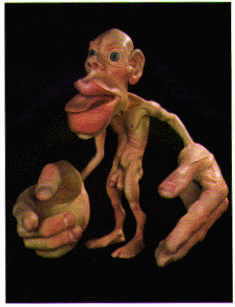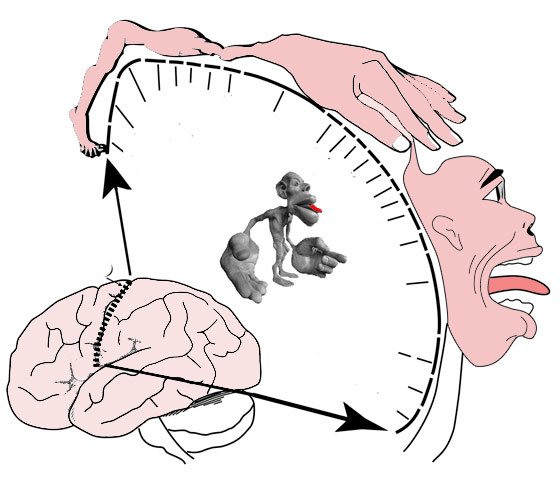Homonculus - FR and EN

Un homonculus (du latin homunculus, composé par homo = "homme" et du suffixe -culus = "petit") est une version miniature, souvent caricaturale, d'un être humain que certains alchimistes cherchaient, prétendument, à créer.
En 1870, deux médecins prussiens découvrent l'implication du néocortex dans le contrôle moteur, à l'aide de stimulations électriques de cette zone sur un chien anesthésié.
En 1930, Wilder Penfield et son équipe reproduisent ces expériences sur des patients au cours d'interventions neurochirurgicales, mettant en avant que les mouvements étaient principalement ordonnés par une stimulation du cortex moteur primaire.
Tout ceci est fort intéressant mais quel est le rapport avec cette histoire d'homonculus ?
Et bien c'est justement là où nous voulions en venir. Des expériences de Penfield, ont découlé une cartographie de ce cortex moteur primaire, et l'homonculus en est la représentation topographique musculaire sur le cortex moteur.

Le corps étant symétrique on retrouve un homonculus comparable au niveau du cortex de chacun des deux hémisphères.
Il montre que des zones importantes du cerveau contrôlent des parties impliquées dans l'exécution des mouvements les plus fins.
Des résultats d'études plus récentes ont mis en évidence qu'en fin de compte il existerait au moins une dizaine d'homonculus moteurs.
Comme illustré sur le 3ème schéma, des études menées sur d'autres espèces ont montré que le cortex moteur était organisé de manière à être adapté à l'exécution des mouvements fins, propres à une espèce. En résumé, comme chez l'humain les parties les plus vastes du cortex moteur servent à contrôler les parties du corps qui effectuent les mouvements les plus fins.
La figure ci-dessous représente l'homonculus humain en comparaison avec d'autres espèces. Nous pouvons noter que les lapins ont une représentation corticale motrice de la tête très importante, les chats pour la gueule et les griffes des membres antérieurs, les singes pour les mains, les pieds et les doigts, celle de l'éléphant est simplement une hypothèse formulée par les auteurs, une cartographie de son cortex n'ayant jamais été réalisée...

Il est important pour le milieu médical et vétérinaire d'avoir une cartographie détaillée de cet homonculus moteur pour pouvoir axer le traitement, par exemple, lors de mouvement anomaux d'une partie du corps.
Et de la même manière nous pouvons décrire un humonculus sensoriel.
Aviez vous déjà entendu parlé de cet Homonculus ?
A homunculus (from the Latin homunculus, composed by homo = "man" and the suffix -culus = "little") is a miniature, often caricatured version of a human being whom some alchemists were allegedly trying to create.
In 1870, two Prussian physicians discovered the involvement of the neocortex in the motor control, using electrical stimulations of this zone on an anesthetized dog.
In 1930, Wilder Penfield and his team reproduced these experiments on patients during neurosurgical procedures, emphasizing that the movements were mainly ordered by stimulation of the primary motor cortex.
All this is very interesting, but what is the relationship with this history of homunculus?
Well, that's precisely where we wanted to go. Penfield experiments have resulted in a mapping of this primary motor cortex, and homonculus is the topographic muscular depiction of the motor cortex.
The body being symmetrical we find a comparable homunculus in the cortex of each cerebral hemisphere.
It shows that important areas of the brain control parts involved in performing the finer movements.
Results of more recent studies have shown that there are at least ten motor homunculus.
As shown in the third picture, studies of other species have shown that the motor cortex is organized in such a way as to be adapted to the execution of the fine movements specific to a species. In summary, as in humans, the larger parts of the motor cortex serve to control the parts of the body which perform the finest movements.
This picture shows the human homunculus in comparison with other species. We can note that the rabbits have a very important cortical motor representation of the head, the cats for the mouth and the claws of the anterior limbs, the monkeys for the hands, the feet and the fingers, that of the elephant is simply a hypothesis Formulated by the authors, a cartography of its cortex has not yet been realized ... ...
It is important for the medical and veterinary community to have a detailed mapping of this motor homunculus to be able to focus the treatment, for example, during anomalous movement of a part of the body.
And in the same way we can describe a sensory humonculus.
Had you ever heard of homunculus before ?
So true!! I learned this at school for a short time...
Thanks for reading